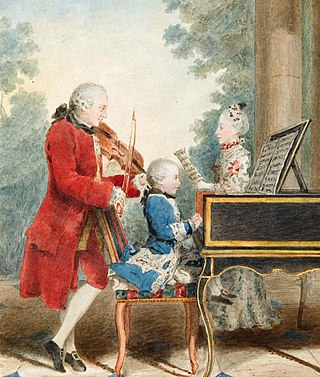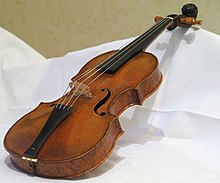
The Classical period was an era of classical music between roughly 1750 and 1820.

Isaac Stern was an American violinist.

In music, a cadenza is, generically, an improvised or written-out ornamental passage played or sung by a soloist or soloists, usually in a "free" rhythmic style, and often allowing virtuosic display. During this time the accompaniment will rest, or sustain a note or chord. Thus an improvised cadenza is indicated in written notation by a fermata in all parts. A cadenza will usually occur over either the final or penultimate note in a piece, the lead-in, or the final or penultimate note in an important subsection of a piece. It can also be found before a final coda or ritornello.

A symphony is an extended musical composition in Western classical music, most often for orchestra. Although the term has had many meanings from its origins in the ancient Greek era, by the late 18th century the word had taken on the meaning common today: a work usually consisting of multiple distinct sections or movements, often four, with the first movement in sonata form. Symphonies are almost always scored for an orchestra consisting of a string section, brass, woodwind, and percussion instruments which altogether number about 30 to 100 musicians. Symphonies are notated in a musical score, which contains all the instrument parts. Orchestral musicians play from parts which contain just the notated music for their own instrument. Some symphonies also contain vocal parts.
A concerto is, from the late Baroque era, mostly understood as an instrumental composition, written for one or more soloists accompanied by an orchestra or other ensemble. The typical three-movement structure, a slow movement preceded and followed by fast movements, became a standard from the early 18th century.

Sonata, in music, literally means a piece played as opposed to a cantata, a piece sung. The term evolved through the history of music, designating a variety of forms until the Classical era, when it took on increasing importance. Sonata is a vague term, with varying meanings depending on the context and time period. By the early 19th century, it came to represent a principle of composing large-scale works. It was applied to most instrumental genres and regarded—alongside the fugue—as one of two fundamental methods of organizing, interpreting and analyzing concert music. Though the musical style of sonatas has changed since the Classical era, most 20th- and 21st-century sonatas still maintain the same structure.

The term string quartet can refer to either a type of musical composition or a group of four people who play them. Many composers from the mid-18th century onwards wrote string quartets. The associated musical ensemble consists of two violinists, a violist, and a cellist.

Chamber music is a form of classical music that is composed for a small group of instruments—traditionally a group that could fit in a palace chamber or a large room. Most broadly, it includes any art music that is performed by a small number of performers, with one performer to a part. However, by convention, it usually does not include solo instrument performances.
A piano trio is a group of piano and two other instruments, usually a violin and a cello, or a piece of music written for such a group. It is one of the most common forms found in classical chamber music. The term can also refer to a group of musicians who regularly play this repertoire together; for a number of well-known piano trios, see below.

The Emerson String Quartet, also known as the Emerson Quartet, is an American string quartet that was initially formed as a student group at the Juilliard School in 1976. It was named for American poet and philosopher Ralph Waldo Emerson and began touring professionally in 1976. The ensemble taught in residence at The Hartt School in the 1980s and is currently (2022) the quartet in residence at Stony Brook University. Both of the founding violinists studied with Oscar Shumsky at Juilliard, and the two alternated as first and second violinists for the group. The Emerson Quartet was one of the first such ensembles with the two violinists alternating chairs.

Recitative is a style of delivery in which a singer is allowed to adopt the rhythms and delivery of ordinary speech. Recitative does not repeat lines as formally composed songs do. It resembles sung ordinary speech more than a formal musical composition.

A piano concerto, a type of concerto, is a solo composition in the classical music genre which is composed for piano accompanied by an orchestra or other large ensemble. Piano concertos are typically virtuosic showpieces which require an advanced level of technique. Piano concertos are typically written out in music notation, including sheet music for the pianist, orchestral parts, and a full score for the conductor.
In music, variation is a formal technique where material is repeated in an altered form. The changes may involve melody, rhythm, harmony, counterpoint, timbre, orchestration or any combination of these.
Sonata form is one of the most influential ideas in the history of Western classical music. Since the establishment of the practice by composers like C.P.E. Bach, Haydn, Mozart, Beethoven, and Schubert and the codification of this practice into teaching and theory, the practice of writing works in sonata form has changed considerably.
James Ehnes, is a Canadian concert violinist and violist.
A major is a major scale based on A, with the pitches A, B, C♯, D, E, F♯, and G♯. Its key signature has three sharps. Its relative minor is F-sharp minor and its parallel minor is A minor. The key of A major is the only key where the Neapolitan sixth chord on (i.e. the flattened supertonic) requires both a flat and a natural accidental.
A solo concerto is a musical form which features a single solo instrument with the melody line, accompanied by an orchestra. Traditionally, there are three movements in a solo concerto, consisting of a fast section, a slow and lyrical section, and then another fast section. However, there are many examples of concertos that do not conform to this plan.
While a concerto is generally a piece for an instrument or instruments with orchestral accompaniment, some works for piano alone have been written with the seemingly contradictory designation concerto for solo piano.
Wolfgang Amadeus Mozart's first four sonatas for keyboard and violin, K. 6–9 are among his earliest works. These were composed by a budding Mozart between 1762 and 1764. They encompass several of Mozart's firsts as a composer: for example, his first works incorporating the violin, his first works with more than a single instrument, his first works in more than one movement and his first works in sonata form. In fact, previous to this, all his works had been short solo-pieces for the harpsichord.

The six sonatas for violin and obbligato harpsichord BWV 1014–1019 by Johann Sebastian Bach are works in trio sonata form, with the two upper parts in the harpsichord and violin over a bass line supplied by the harpsichord and an optional viola da gamba. Unlike baroque sonatas for solo instrument and continuo, where the realisation of the figured bass was left to the discretion of the performer, the keyboard part in the sonatas was almost entirely specified by Bach. They were probably mostly composed during Bach's final years in Cöthen between 1720 and 1723, before he moved to Leipzig. The extant sources for the collection span the whole of Bach's period in Leipzig, during which time he continued to make changes to the score.












